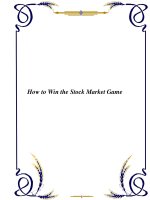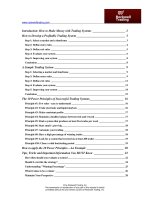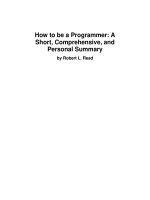Tài liệu How To Use Volume And Technicals To Improve Reliability And Profitability Of Breakouts pdf
Bạn đang xem bản rút gọn của tài liệu. Xem và tải ngay bản đầy đủ của tài liệu tại đây (66.33 KB, 5 trang )
How To Use Volume And Technicals To Improve Reliability
And Profitability Of Breakouts
By Mark Boucher
Investors following a strategy similar to the one I teach
here
at
TradingMarkets.com, as well as those who follow an O'Neil type strategy, are apt
to be buying breakouts to new highs frequently. If you're going to be buying
breakouts of four-week-plus flags or five-week-plus cup-and-handles, you need
to know all the variables that can help you improve the percentage of these
trades that are profitable and/or can help you highlight stocks that have a higher
likelihood of moving substantially higher following a breakout. Fortunately, there
are a number of technicals that can help a trader in this regard.
This month, we'll cover five technical tools that our research shows help increase
the reliability of a breakout moving in the intended direction. By putting as many
of these as possible together, traders can substantially improve their odds of
success in trading breakouts of any kind. Here are the top five things we look for
on a breakout to help confirm that a substantial move is in the making (in order of
importance):
1.
Breakout day closes over pivot resistance and occurs on a
TBBLBG.
The most important variable is the price action made on the
day of a breakout. TBBLBG stands for T
hrust Breakout, Breakaway Lap,
or B
reakaway Gap. The day of the breakout (a new four-plus week high
in price) should make one of these three runaway price action patterns.
These patterns are described in my 10-week trading course. For a quick
review, a Thrust is a large-range day where the close is in the top third of
the range which occurs on volume higher than the previous day. A Lap
up is a day where today's low is greater than yesterday's close. A Gap up
is a day where today's low is greater than yesterday's high. (See Figure
1.)
Figure 1.
2.
Breakout-day closes over pivot resistance and occurs on strong
volume (20% over 50-day MA or near record volume since the
trading range began.)
The second most important variable is the
volume action on the day of breakout. You definitely want strong volume
on the day of the breakout to show significant demand is coming in.
Demand volume at least 20% above the 50-day MA of volume on your
breakouts and your odds will improve. Strong volume can also be
defined as the very highest volume since the trading range started. (See
Figure 2.)
Figure 2.
3.
Breakout is confirmed by a higher level of relative strength than
occurred since the trading range began.
When a stock breaks out in
price and also in its Relative Strength vs. other stocks, it is much more
likely to be a true market leader and is more likely to follow through. (See
Figure 3.)
Figure 3.
4.
Prior to the breakout day, the trading range showed more
accumulation days than distribution days.
An accumulation day is a
day where prices rise on volume higher than the previous day. A
distribution day is a day where prices fall on volume higher than the
previous day. A strong stock will show more accumulation days than
distribution days during its trading-range consolidation prior to breakout.
The second chart of ACRT is an example. If you count up-volume days
that are more up vs. up-volume days that are down, there are three more
up-volume days that are up than down prior to the breakout day. (See
Figure 4.)
Figure 4.
5.
One or more of four volume accumulation indexes breaks out to a
new high (new high prior to trading range) before the breakout day
in price.
We use Money-Flow, OBV, William's Accumulation, and Volacc
as volume accumulation indexes (see Science of Trading Course). If you
have access to any of these, check to see that your stock has at least
one of these volume accumulation indicators breaking out to new highs
ahead of price. (See Figure 5.)
Figure 5.
The larger the number of these that confirm a breakout in price, the more likely
that you've got a breakout that will move in the desired direction. In addition,
most of the very strongest moves following breakout are accompanied by at least
3/5 of these characteristics.
While these confirmation tools will help you trade any type of breakout, they work
particularly well on high RS high EPS stocks breaking out to new highs, such as
those we trade and those O'Neil trades. So before you get too excited about a
four-week-plus flag or cup-and-handle breakout in a strong RS and EPS stock in
a leading group, check these five features and be sure you have at least one of
these in your favor, and preferably two or more.
Copyright © 2001 by TradingMarkets.com, Inc.









